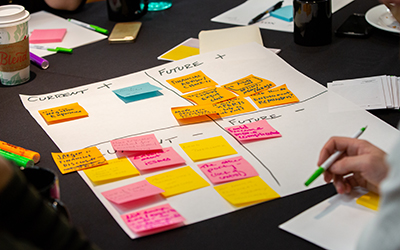Applying Qualitative Research Methods to Design Thinking
People frequently associate research with a handful of methods, such as surveys or measuring differences over time or between groups—that is to say, people frequently associate research with strictly quantitative methods. These methods work very well for testing a specific hypothesis. However, especially when a topic is not yet well-understood, embarking on a study with a specific set of expectations about the outcome is not always wise. Doing so can lead researchers to build their own biases into the study. Further, surveys and the like limit a participant’s ability to think creatively and provide in-depth input on a topic. To circumvent potential bias issues and to allow for a deeper dive into the topic of interest, researchers turn to methods such as interviews or focus groups—that is, qualitative methods.

Following this line of reasoning with the Court Compass project, we employed a workshop strategy—our design sprints—allowing groups of participants to work together to first identify problems with the legal divorce process and then to develop creative solutions to those problems. By using such broad qualitative methods, we allowed room for findings and responses that we otherwise might not have considered. For instance, had we only sent a survey to the public asking what aspect of the legal divorce process most needed improvement, respondents would be selecting answers from a finite list and we would have to guess why they answered the way they did. Additionally, we would have run the risk of respondents choosing response options closest to their actual answer, therefore never knowing their full answer.
In contrast, our design sprints sought to identify problems and their potential solutions, and accomplished this through a variety of group activities, where group members consist of both self-represented litigants and legal professionals. These methods encourage creative thinking through open-ended questions, visual exercises, and organizational activities. By allowing self-represented litigants and stakeholders to discuss how they would improve the system with few constraints, we minimized our own bias and allowed the participants’ real-world experiences to guide the research. Participants developed ideas that ranged from practical—for instance, a website to navigate the process—to comically impractical—such as free beer in the courts. Importantly, every single idea shared, even those at the extremes of practicality, shed light on specific aspects of the process that participants would want to see changed and how they would suggest doing so.
Our open-ended approach allowed us to gain a wealth of knowledge about the experiences of pro se litigants in family court. We now have a better understanding of where self-represented litigants actually struggled in the process as well as creative solutions to improve the process. With this knowledge, we hope to make meaningful suggestions for changes to a process experienced by millions of people every year.




